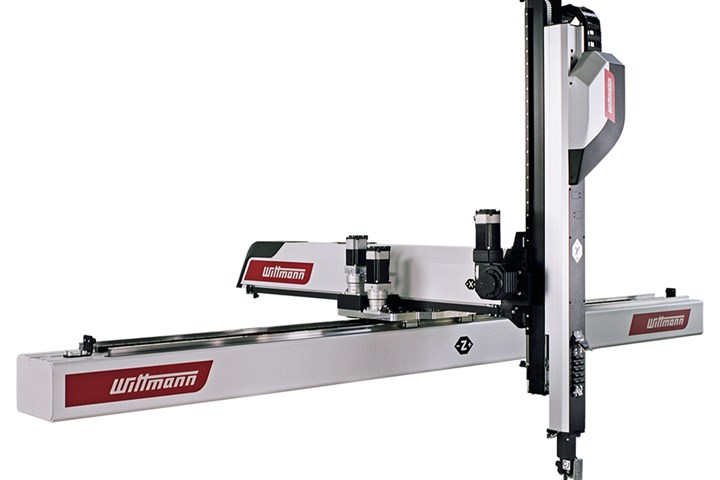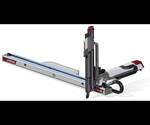Automation: Robot Series Extended to Support Larger Machines
Wittmann Battenfeld latest Primus robot—48/48T—can support injection molding machines with up to 1200 tons of clamping force.
Launched in 2018, Wittmann Battenfeld’s Primus robot line supported machines with up to 400 tons of clamping force when it first launched, later expanded to 900 tons. Included in the company’s virtual rollout of products it would have displayed at Fakuma, the new Primus 48/48T has 20-kg (44 lb) of payload and can be paired with injection molding machines featuring up to 1200 tons in clamping force, up from 900 tons when first shown at K 2019 (read more). The robot’s max horizontal stroke of 9 m (30 ft) allows it to reach several pallet bays arranged beside the injection molding machine. Alternatively, part depositing could be positioned behind the machine’s clamping unit.

The Wittmann Battenfeld 48/48T robot can support injection molding machines with up to 1200 tons of clamping force.
The robot features a continuous drilling pattern as standard, enhancing its flexibility. Its demolding axis’s maximum stroke is 1200 mm (47 in.), while the vertical range goes from 1400 (55) to 2000 mm (79 in.) Within the 1400-to-1600-mm (55-to-63-in.) range, customers can choose between the Primus 48 single axis and the Primus 48T telescopic version, both of which feature a 20-kg (44-lb) payload. It also has a movable x-axis, like the Primus 26/26T models, which are now recommended for presses up to 900 tons, vs. 400 tons previously.
The Primus 48/48T comes with a completely re-designed vertical tube, with rigidity reportedly comparable to that of the WX line. On the vertical tube of Primus 48/48T, only the quick couplers for vacuum, compressed air and gripper feedback are visible, with the hosing concealed inside. In a virtual press event, Wittmann Battenfeld Managing Director Michael Wittmann said the Primus comes with the R8 TeachBox running R8 Primus software, and it can support the company’s patented Smart Removal function. Each axis has double linear guiding.
Related Content
-
Processing Megatrends Drive New Product Developments at NPE2024
It’s all about sustainability and the circular economy, and it will be on display in Orlando across all the major processes. But there will be plenty to see in automation, AI and machine learning as well.
-
Real-Time Production Monitoring as Automation
As an injection molder, Windmill Plastics sought an economical production monitoring system that could help it keep tabs on its shop floor. It’s now selling the “very focused” digital supervisor it created, automating many formerly manual tasks.
-
Scaling New Heights With Vertical Integration
Eden Manufacturing was founded on a vision of vertical integration, adding advanced injection molding capabilities to a base of precision moldmaking and more recently bringing Swiss-type machining capabilities in-house.












